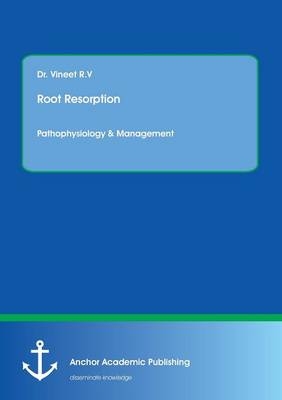
Root resorption
Anchor Academic Publishing (Verlag)
978-3-95489-407-9 (ISBN)
Dr. Vineet R.V is currently a faculty member at Sree Mookambika Institute of Dental Sciences, India. He received his Bachelor of Dental Surgery degree from the reputed Tamil Nadu Dr.MGR Medical University and obtained his Master of Dental Surgery degree from the Rajiv Gandhi University of Health Sciences with high academic excellence. He has many research publications to his credit in several national and international indexed journals and he is in the editorial review board of various peer reviewed national and international scientific journals.
'Text sample:
Chapter ETIOLOGY AND PATHOGENESIS:
For internal root resorption to occur, the outermost protective odontoblast layer and the predentin of the canal wall must be damaged, resulting in exposure of the underlying mineralized dentin to odontoclasts. The precise injurious events necessary to bring about such damages have not been completely elucidated. Various etiologic factors have been proposed for the loss of predentin, including trauma, caries and periodontal infections, excessive heat generated during restorative procedures on vital teeth, calcium hydroxide procedures, vital root resections, anachoresis, orthodontic treatment, cracked teeth, or simply idiopathic dystrophic changes within normal pulps. In a study of 25 teeth with internal resorption, trauma was found to be the most common predisposing factor that was responsible for 45% of the cases examined. The suggested etiologies in the other cases were inflammation as a result of carious lesions (25%) and periodontal lesions (14%). The cause of the internal resorption in the remaining teeth was unknown. Other reports in the literature also support the view that trauma and pulpal inflammation/infection are the major contributory factors in the initiation of internal resorption.
Wedenberg and Lindskog reported that internal root resorption could be a transient or a progressive event. In an in vivo primate study, the root canals were accessed in 32 incisors with the predentin intentionally damaged. The access cavities in half of the teeth were sealed; the other half were left open to the oral cavity. The teeth were extracted at intervals of 1, 2, 6, and 10 weeks. The authors noted only a transient colonization of the damaged dentin by multinucleated clastic cells in the teeth that had been sealed (ie, transient internal root resorption). Those teeth were free from bacterial contamination, and no signs of active hard tissue resorption occurred. In the teeth that were left unsealed during the experimental period, there were signs of extensive bacterial contamination of pulpal tissue and dentinal tubules. Those teeth demonstrated extensive and prolonged colonization of the damaged dentin surface by clastic cells and signs of mineralized tissue resorption (progressive internal root resorption). Damage to the odontoblast layer and predentin of the canal wall is a prerequisite for the initiation of internal root resorption. However, the advancement of internal root resorption depends on bacterial stimulation of the clastic cells involved in hard tissue resorption. Without this stimulation, the resorption will be self-limiting.
For internal resorption to occur, the pulp tissue apical to the resorptive lesion must have a viable blood supply to provide clastic cells and their nutrients, whereas the infected necrotic coronal pulp tissue provides stimulation for those clastic cells. Bacteria might enter the pulp canal through dentinal tubules, carious cavities, cracks, fractures, and lateral canals. In the absence of a bacterial stimulus, the resorption will be transient and might not advance to the stage that can be diagnosed clinically and radiographically. Therefore, the pulp apical to the site of resorption must be vital for the resorptive lesion to progress. If left untreated, internal resorption might continue until the inflamed connective tissue filling the resorptive defect degenerates, advancing the lesion in an apical direction. Ultimately, if left untreated, the pulp tissue apical to the resorptive lesion will undergo necrosis, and the bacteria will infect the entire root canal system, resulting in apical periodontitis.
HISTOLOGIC MANIFESTATIONS:
Wedenberg and Zetterqvist studied, internal root resorption lesions in both primary and permanent teeth using light microscopy, scanning electron microscopy, and enzyme histochemistry. The study examined 6 primary and 7 pe
| Erscheinungsdatum | 19.07.2016 |
|---|---|
| Sprache | englisch |
| Maße | 155 x 220 mm |
| Gewicht | 141 g |
| Themenwelt | Medizin / Pharmazie ► Zahnmedizin ► Praxismanagement |
| ISBN-10 | 3-95489-407-6 / 3954894076 |
| ISBN-13 | 978-3-95489-407-9 / 9783954894079 |
| Zustand | Neuware |
| Haben Sie eine Frage zum Produkt? |
aus dem Bereich


